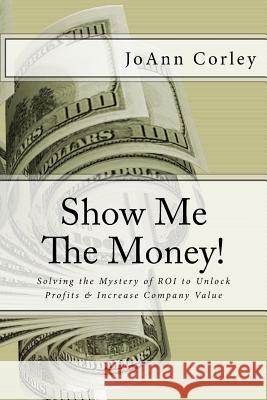Show Me The Money!: Solving the Mystery of ROI to Unlock Profits & Increase Company Value » książka
Show Me The Money!: Solving the Mystery of ROI to Unlock Profits & Increase Company Value
ISBN-13: 9781540360281 / Angielski / Miękka / 2016 / 98 str.
Show Me The Money!: Solving the Mystery of ROI to Unlock Profits & Increase Company Value
ISBN-13: 9781540360281 / Angielski / Miękka / 2016 / 98 str.
(netto: 56,82 VAT: 5%)
Najniższa cena z 30 dni: 59,50
ok. 16-18 dni roboczych
Dostawa w 2026 r.
Darmowa dostawa!
Show Me The Money In fact show me how to spend the money, is really what many leaders are saying. As companies have moved to an employee, human-centric era, where company culture and relationship to leaders are key components, one operational consideration that many grapple with is how to spend money wisely. Some are in a quandary about how to spend money in providing a great employee experience. And, by the way, some of these leaders are baby-boomers who've had a completely different work culture experience growing up and for those who've lead, a different sensibility about money regarding how and when it should be spent. This current cultural conditions can challenge the values and beliefs these leaders hold dear and have contributed to their success. However, what Marshall Goldsmith says really rings true, "What got you here, may not get you there." (It's the title of one of his books). To lead these kinds of companies, the philosophy and values of their leaders must be evolving as well. And that's crucial because it's from beliefs, philosophies, and values that decisions are made - particularly decisions regarding the use of money. **The contents of this book serves to build financial/operational considerations for every leader and manager, whether they have p/l responsibility or not. This sensibility is sorely missing in most leaders and is costing your company money.** How money is spent is a reflection of how a leader thinks and what is valued ...and their understanding of how to maximize the use of money to successfully manage and grow a company. For example, do they see spending money on and for employees as a cost or an investment? There is lots of legitimate confusion here and that is the purpose of this handbook. Another example: are they keenly aware of how their own leadership effectiveness impacts the financials of the company? You'll find this handbook particularly useful if you've ever said to yourself, ? "We can't afford training." ? "I know my leaders and managers need help, it's just not in our budget right now." ? "I've heard that coaching is helpful, but how can we really measure return on investment?" ? "We can't afford to fire that manager." ? "Honestly, I think employee training is a waste of time and money." ? "How do we determine the financial impact of our employee rewards program?" What have you or your leadership team thought or said similar to these? These and many others are extremely common and appropriately so. The way employee training has been executed over the years, for example, has not gotten the results and return needed and expected and as an industry, we've been addressing that. However, there still is the gaping need to put these kinds of activities into a financial context. That need, if not met, will continue to stifle the growth of some companies and substantially cripple it for others. I don't wish that for any company and in fact wish great success for all. Another unfortunate, yet popular aspect of corporate life is keeping bad managers. If all leaders were more attune to the financial impact of doing so, this practice would be sure to change What This Handbook Offers So, I've written this handbook as a simple guide to meet this challenge and which will enhance your company operations by way of... > A brief introduction to an employee-human centric approach to leadership > An introduction to the intricate role of human behavior (or what I term "people power") to operational success and how to leverage it. > How to measure human behavior > How to determine and calculate the ever-elusive ROI It is my firm belief that use of any of the information from this handbook will help you grow your profits and company value - at least that's what my clients have experienced Here to support your continued growth & success "
Zawartość książki może nie spełniać oczekiwań – reklamacje nie obejmują treści, która mogła nie być redakcyjnie ani merytorycznie opracowana.











